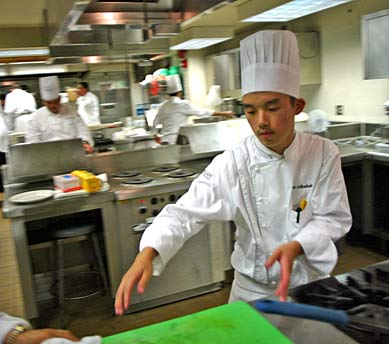
|
Food inspires chefs’
artistic expression
Confections serve as media for
a culinary menagerie at KCC
Richard the rooster was a scraggly fella who made his living scavenging in back yards. An unlikely source of inspiration for a work of art.
Yet there he was, Richard, immortalized in chocolate, surrounded by the other animals of the Chinese zodiac, equally immortalized in marzipan. Immortalized, at least, until someone gets hungry for something sweet. Or they melt.
Such is the nature of the culinary showpiece: lovely, yet perishable.
At Saturday's Hawaii State Culinary Expo at Kapiolani Community College, a mix of student and professional chefs showed off this art form in competition. They filled a dining room with pieces made of real food, from sugar to chocolate to fresh fruit to fish.
KCC culinary students Kuulei Carvalho and Anna Heil decided on a candied recreation of the zodiac. It took them five full school days, plus time at home, to make all the animals out of marzipan, mold a round chocolate base and pipe 12 Chinese characters onto discs of white chocolate.

John Truong and Hanyoung Cho, above, check out the Winnie-the-Pooh-themed pastry display that won the best of show award in the cold-food competition for a team from Farrington High School.
The rooster was the spiritual incarnation of a stray bird that used to visit Carvalho's grandmother's yard. "When he was gone, she really missed Richard," Carvalho said, so the family bought her a ceramic substitute.
She and Heil used the little statue to make the mold for their chocolate Richard. Their creation earned them a special silver medal from show chairman Daniel Swift.
Richard was entered in the cold-food competition, consisting of dishes delivered to the dining room after many hours of preparation.
A separate hot-food contest involved a one-hour intensive cooking session before judges from the American Culinary Federation. Contestants had to prepare four plates of one dish and were judged on their technique as well as the finished product.
Clarence Nishi, culinary coordinator for Kauai Community College, brought four of his students to compete and was watching them -- "like an expectant father" -- as they all sweated it out in a KCC kitchen.
What the timed exercise teaches, Nishi said, is the organizational savvy to handle the pressure of real restaurant work. "They hone their skills. They get that sense of urgency. That's what a lot of students don't have -- 'You mean I gotta serve five minutes ago?'"
They are not competing against each other so much as they are challenging themselves to meet a set of culinary standards, Nishi said.

In the hot-food competition, left, Royce Arakaki battled the clock to finish his dish in a busy KCC kitchen. The hot-food award went to KCC student Sonny Acosta.
In the cold-food room, meanwhile, it wasn't about taste.
Imagine those displays of plastic food in Japanese restaurants -- only these were prettier and smelled real, if you got real close.
KCC student Lance Kitohara's silver-medal creation carried the weighty title of "A Five-Course Gastronomique Menu Celebrating Beauty of a Sunset in the Fall Twilight."
It was all real food, from the rabbit terrine to the turkey consomme to the delicate poached leek served with pomegranate vinaigrette. You couldn't eat any of it, though, as it was all glazed with gelatin to keep it firm for display.
Still, Kitohara said, you can't fool the judges by faking it, for example by passing off colored water for broth. "They're going smell it and they can tell it's consomme."
He started at noon Friday and finished at 6 a.m. Saturday. "At 3 in the morning I was glazing everything and I was thinking, 'Glazing really sucks.'"
At that point, perhaps, does the thought, "There are starving people in the world and here I am making food no one can eat" cross the mind?
Kitohara admitted it's hard to explain this art form to people who don't understand the venerable tradition of the culinary showpiece. "They're, like, 'I don't understand the concept of making food that's not really going to be eaten.'"
He said he is careful not to use any more food than he needs, and that the techniques and flavor combinations he learns while making his showpieces are put to use when he works on real meals.
The idea is to illustrate a theme through food and to present your dishes in their ultimate visual form, he said. All part of being a chef. "Your concept is supposed to come to life on your plate."
programs.kcc.hawaii.edu/fshe/culinary.htm
[News] [Business] [Features] [Sports] [Editorial] [Do It Electric!]
[Classified Ads] [Search] [Subscribe] [Info] [Letter to Editor]
[Feedback]
